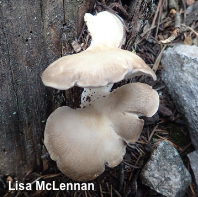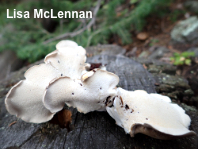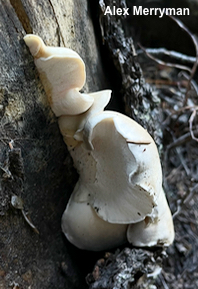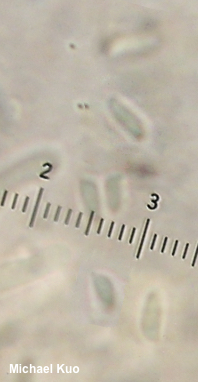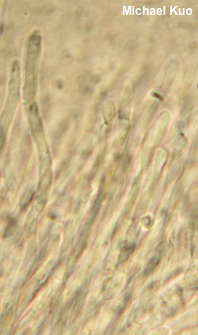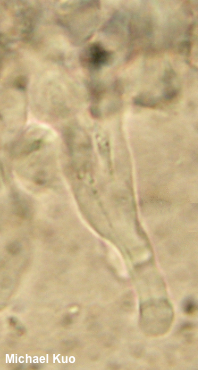| Major Groups > Polypores > Stemmed, Pale-Fleshed > Osteina obducta |

|
[ Basidiomycota > Polyporales > Fomitopsidaceae > Osteina . . . ] Osteina obducta by Michael Kuo, 18 June 2024 This curious polypore features a fairly substantial stem, laterally attached to the deadwood of conifers. The cap is smooth and whitish to grayish or pale brown, and the pore surface is white, composed of small, angular pores. Osteina obducta appears to be fairly widespread in North America, judging from the online records of major herbaria, but far more common in western and northern ecosystems. One of the most distinctive features of Osteina obducta cannot be determined until it is dried for study; its firm but pliant flesh becomes extremely hard—we're talking, like, hard as a rock. The first time a collection was sent to me I was sure that it had been baked in a kiln for a few days; I had to rehydrate a small section for hours before I could work with it. It wasn't until I began consulting polypore literature that I discovered that Osteina obducta was supposed to be like that: "very rigid and brittle when dry" (Berkeley 1845, in the first description of the fungus), "the context dries hard" (Overholts 1953); "hard and horny when dry" (Gilbertson & Ryvarden 1987) (let it go). Under the microscope Osteina obducta is not much fun to work with. Its spores are tiny and colorless, making them hard to find—and it has two kinds of hyphae, one of which is partially gelatinized and hard to isolate, while the others are so tightly wound together that they, too, are hard to see individually. Polyporus zelleri, Polyporus osseus, and Oligoporus obductus are synonyms. Thanks to Lisa McLennan and Alex Merryman for collecting, documenting, and preserving Osteina obducta for study; their collections are deposited in The Herbarium of Michael Kuo. Description: Ecology: Saprobic on the deadwood of conifers (and rarely reported on the deadwood of hardwoods); causing a brown rot; growing alone or gregariously, usually in overlapping clusters; annual; originally described from "British North America" (Berkeley 1845, referring to what is now the United States from the Mississippi River eastward); fairly widely distributed in North America but more commonly reported from montane and northern areas; also known from central Europe, China, and Japan. The illustrated and described collections are from Colorado. Cap: 4–10 cm across; broadly convex; more or less semicircular to fan-shaped; the margin becoming widely scalloped; dry; bald; whitish, grayish, or pale brown (usually becoming brown when dried for study). Pore Surface: Running down the stem; whitish to dull yellowish; not bruising; 3–5 angular pores per mm; tubes 2–3 mm deep. Stem: 2–5 cm long; 1.5–2 cm thick; tapered to base; bald; whitish to grayish or brownish; not bruising. Flesh: Thick and pliant when fresh; white; not changing on exposure; when dried becoming extremely hard. Microscopic Features: Spores 3–5 x 1–2 µm; cylindric, with the apicular end subacute; smooth; hyaline in KOH; inamyloid. Basidia 25–30 x 3–5 µm; clavate; 4-sterigmate. Cystidia not found. Setae not found. Hymenial trama hyphae 2–4 µm wide; thin-walled; smooth; hyaline in KOH; tightly wound together. Contextual hyphae 5–10+ wide; walls 2–5 thick; smooth; hyaline in KOH; with large, looping clamp connections; partially gelatinized and difficult to isolate. REFERENCES: (M. J. Berkeley, 1845) M. A. Donk, 1966. (Murrill, 1915; Overholts, 1953; Smith, 1975; Breitenbach & Kränzlin, 1986; Gilbertson & Ryvarden, 1987; Phillips, 1991/2005; Lincoff, 1992; Cui et al., 2014; Ginns, 2017; Shen et al., 2019.) Herb. Kuo 08011801, 08292301. This site contains no information about the edibility or toxicity of mushrooms. |
© MushroomExpert.Com |
|
Cite this page as: Kuo, M. (2024, June). Osteina obducta. Retrieved from the MushroomExpert.Com Web site: http://www.mushroomexpert.com/osteina_obducta.html |
